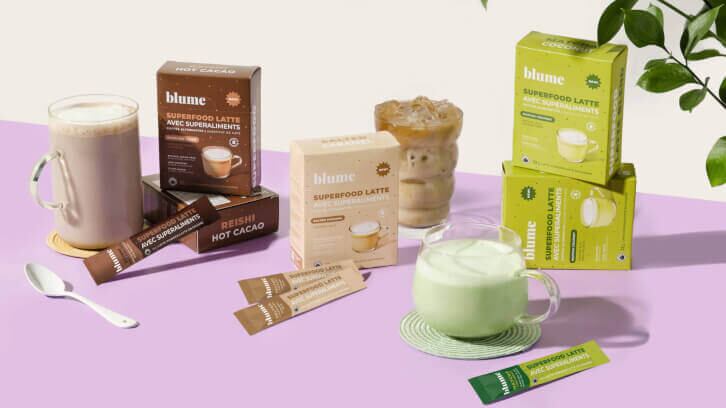Rather than mimicking or replacing coffee, Danudjaja said that she understands that consumers still value their coffee rituals, but often find over caffeination leads to adverse effects.
Instead, Blume encourages a post-coffee experience for consumers, where they can “create a new ritual to replace your second, third cup of coffee,” with blends that contain “functional ingredients … and 90% less sugar than what the alternatives would.”
“People are never going to keep up a ritual unless it is delicious and really satisfies what you have in your mind. The emotional cue that you have for these rituals that are so ingrained,” she said.
Blume’s adaptogenic latte blends, which retail for $12.99 for a box of eight single-serve pouches, are a mix of familiar favorites like Gingerbread, Salted Caramel and Mint Cocoa, and more niche flavors like Blue Lavender, Rose London Fog Blend and Reishi Hot Cacao.
Each flavor blend is conncted to a function, like its Matcha Coconut blend, made with matcha, moringa and l-theanine, to provide energy; or Blue Lavender blend, which highlights rest via its ingredient list of lavender, blue spirulina and coconut milk.
The flavor-forward branding is strategic, Danudjaja said, allowing the brand to grab consumers’ attention on shelves, while dedicating the back of pack to education on ingredients and corresponding functionalities.
Blume’s strategy to communicate ingredient benefits is based on nutritional science, Danudjaja emphasized, rather than messaging on the historical use of an ingredient. She noted that while consumer education in DTC channels was easier, building a consumer base in retail opens the opportunity for more in-person education and sampling.
Overcoming funding challenges, expanding North American retail presence
As a woman of color-founded business, Danudjaja expressed the difficulty she faced in the first five years of business since it started in 2017, despite the limited coffee alternative options available in the market.
In 2020, only 2.3% of VC funding was allocated for women-led startups, a half percentage point decline from 2019, with women of color businesses receiving less—despite research showing that companies who have women on the executive level are 25% more likely to demonstrate above-average profitability.
However, Danudjaja saw investor interest in Blume grow during the pandemic when consumers were concerned about their health and seeking products that provided immunity, stress and sleep support.
In summer 2023, she highlighted the brand raising CA$2.5m from angel investors across North America.
Disrupting the $1.9bn coffee alternative market, Blume is seeing growth in both DTC and in 4,000 retailers, including Whole Foods, Erewhon, Loblaws, Grove, Well.ca and more recently, Target.
Since its recent expansion into Target, Blume reported that it’s on track for its first eight figure year with 30% YoY growth.
Building consumer trust through familiar flavors
When Danudjaja started Blume as a side business in 2017, she initially began with the turmeric blend, citing her Indonesian heritage as the foundation to her interest in its benefits; and as the brand evolved, more flavors and functionalities were introduced to its evolving consumers, with familiar flavors driving its growth.
Blume’s audience who requested familiar flavors like pumpkin spice and salted caramel, most commonly through social media, allowed the brand to gain the loyalty of its consumers, while connecting with a consumer base who were new to the category. Danudjaja added that Blume’s best seller was its pumpkin spice blend, a limited flavor offered only six weeks out of the year, highlighting the drive behind familiarity.
She added that the development of these familiar flavors “open [the brand] to this new audience, attracting new people to the category and making it accessible because you’re using things they understand. It’s a way into the brand and we hope to move them to other flavors.”
Danudjaja elaborated, “So if you love cocoa, it’s a way to understand it. You come into the brand and then we can educate you on superfoods on caffeine-free alternatives and move you to other beverages, other flavors. You get to try and experiment once we’ve built some trust on something that delivers on what you expected.”


